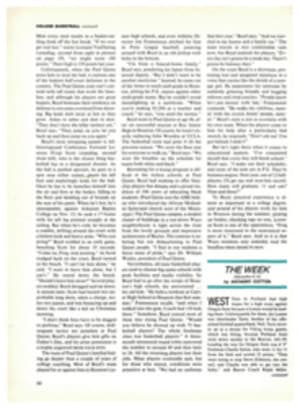
THE TALL STORY IN SKIING THESE DAYS IS A BOOT THAT EXTENDS TO THE KNEE
Just when we thought that our fiber-glass skis and foam-injected boots would be good for 10 years before going out of style, the equipment makers have done it again. After years of claims that shorter skis are easier and better for the recreational skier, long skis are in vogue again. Manufacturers declare that what everyone wants now is "high performance."
Well, maybe, but a skier can't have high performance if he has a hard time turning. So, to go with the longer skis, bootmakers have come up with a blockbuster: knee-highs that aren't exclusively for experts and racers. They're for the novice and intermediate skier as well, and they're a blessing, because with the increased leverage they provide, less muscle is needed to make turns. The early models—by Dolomite, Nordica and Tecnica—range in price from $235 to $295 and are already in the shops. But the serious skier would be wise to wait for the boots that will let him drive his skis with the precise handling of a sports car—the Kastinger-Porsche Design boot, which will sell for around $390 the pair.
The sleek, charcoal-colored Porsche has a futuristic look, as though it were custom-made for Darth Vader. But what you don't see is even more impressive. Under the hood, so to speak, is a finely tuned machine that far outperforms the other knee-highs. The boot, built by Kastinger and Co., an Austrian manufacturer that has been making ski boots since 1909, was designed by an unassuming American engineer named Daniel Post, who tinkered with the first crude models in the basement of his Averill Park, N.Y. home.
Post, 51, now a professor in the Engineering Science and Mechanics Department at Virginia Tech, is an inventor who has worked in diverse fields. He holds six patents—two for his revolutionary boot. Post is not a crack skier. He and his wife, Frieda, say they are timid on the slopes. But their three children are something else—pro skiers all—and they indirectly planted the idea for a new boot design in their father's head.
Irwin, 27, was a certified ski instructor before he became an engineer, and his sisters, Ellen and Marion, 25-year-old twins, traveled the professional freestyle circuit for five years. Ellen teaches skiing at Winter Park, Colo. and is one of only two women on the Professional Ski Instructors of America demonstration team. Marion, attending Colorado State, had a career that included three overall world freestyle titles and five world ballet championships.
"The children were obsessed with skiing," says Post. "It dominated their conversation day and night. We discussed the mechanics of the sport, frequently with emphasis on the contribution of the boot. Then, eight years ago, I heard a presentation by Billy Kidd in which he talked about the motion of the legs for turning. That crystallized my thinking that a skier could transfer motion to the skis more efficiently with a different style boot."
By the spring of 1972, father and son were trying out the first prototypes, made of old laced-up boots and steel uppers. "We used materials that were easy to construct," says Post, "because geometry, not the material, is the key here."
The early version of Post's boot illustrates the mechanics behind the design. There's a stiff structural member that rises up from the heel around to a precise point on the shin just below the knee. The structure, or lever, gives the boot lateral stiffness. The feature that makes Post's design better than that of other knee-highs is that at the shin of his boots this structure attaches to a stiff plastic yoke that connects to a soft flexible cuff hugging the strongest part of the calf. When the leg moves, so does the yoke, transmitting the motion of the front of the leg to the bottom part of the boot and the ski.
"With a conventional ski boot, the side of the leg pushes against the sidewall of the boot, causing it to 'angulate' and edge the ski," says Post. "With our concept, the boot angulates through the action of the front of the leg. As the skier flexes his legs to angulate the skis, his lower legs also rotate through a vertical axis. This is an automatic and natural motion dictated by human anatomy that occurs unconsciously with angulation."
As a result of this rotation, the front of the leg moves farther sideways than does the side of the leg. Boots actuated by the front of the leg therefore yield a greater angulation than the conventional boot. Post calls this "amplification of edging," and in practice, it means that with a smaller body motion, a skier wearing the new boot can achieve the same angulation of the ski as a low-boot skier. The advantages include quicker maneuvers and less fatigue. The novice finds his first snowplows are a cinch, and the advanced skier can carve parallel turns with more precision and ease.
There are other advantages to the Kastinger-Porsche boot. Because the upper part of the leg controls the ski, there is no need to immobilize the ankle, so the foot is less constricted and more comfortable than in a conventional boot. The boot, it is hoped, will significantly reduce injuries by eliminating boot-top fractures of the tibia and fibula. Also, the Kastinger-Porsche boot is designed so that the ankle is free to absorb part of the shock in a fall, and while the strong brace on top of the calf makes recovery from a precarious position easier, the knee will not be any more vulnerable than it is in lower boots.
Eddie Ferguson, the 1973 world freestyle champ who used to be called "Airborne Eddie," tested Post's prototype in 1977. "For two weeks we put it through every stage there is," he says, "all the way from snowplow turns to sideslips down the hill, to mogul skiing, racing, flips, you name it. I found it did everything I wanted better and more easily than shorter boots I had skied with. After trying the other knee-highs earlier this season, I found Dr. Post's concept of that rotational motion in the lateral movement to be very, very effective."
"I knew right away that it was a revolutionary idea," says Hermann Kastinger, the 34-year-old president of his family's firm, who first learned of Post's invention when he checked a list of new patents. Three years ago, Kastinger called Ferdinand Porsche, 43, grandson of the famous car maker, who runs Porsche Design in Austria, and asked him to put a beautiful body on the boot.
The finished Kastinger-Porsche is adjustable from top to bottom to fit a skier's size and ability. Even the forward lean is mechanically controlled. It has an external spring reaching from the boot toe to the lower shin that acts as a shock absorber and a cable around the ankle that's secured to a padded strap around the instep that draws the instep back into the heel pocket for a more comfortable fit. And—special blessing—the boot has no buckle closings to fiddle with while your fingers freeze. Instead, the back of the boot hinges out to allow you to step quickly in and out.
The nicest thing about this boot is that, for once, a piece of ski equipment has not been perfected solely to help racers go faster. "Ski racers are so aggressive, they don't have any edging problems," says Ken Harrell, who is vice-president of Kastinger U.S.A. "It's the beginners who need a lift."
Kastinger is planning full-fledged production for the 1981-82 season, but this winter the boots will be as hard to come by as pandas. Only 1,000 pairs have been produced so far—all in men's sizes—and 400 are earmarked for the U.S. These will be sold primarily to those Kastinger calls "opinion leaders" in the ski business. By next year, though, any skier who wants to will be able to weave down the slopes in Porsches.
ILLUSTRATION
MIKE HODGES
A cutaway view of the Kastinger-Porsche shows how the boot hugs the leg. The strap, pad, yoke and lever are highlighted in green.
STRAP
PAD
SHALLOW YOKE
LEVER

